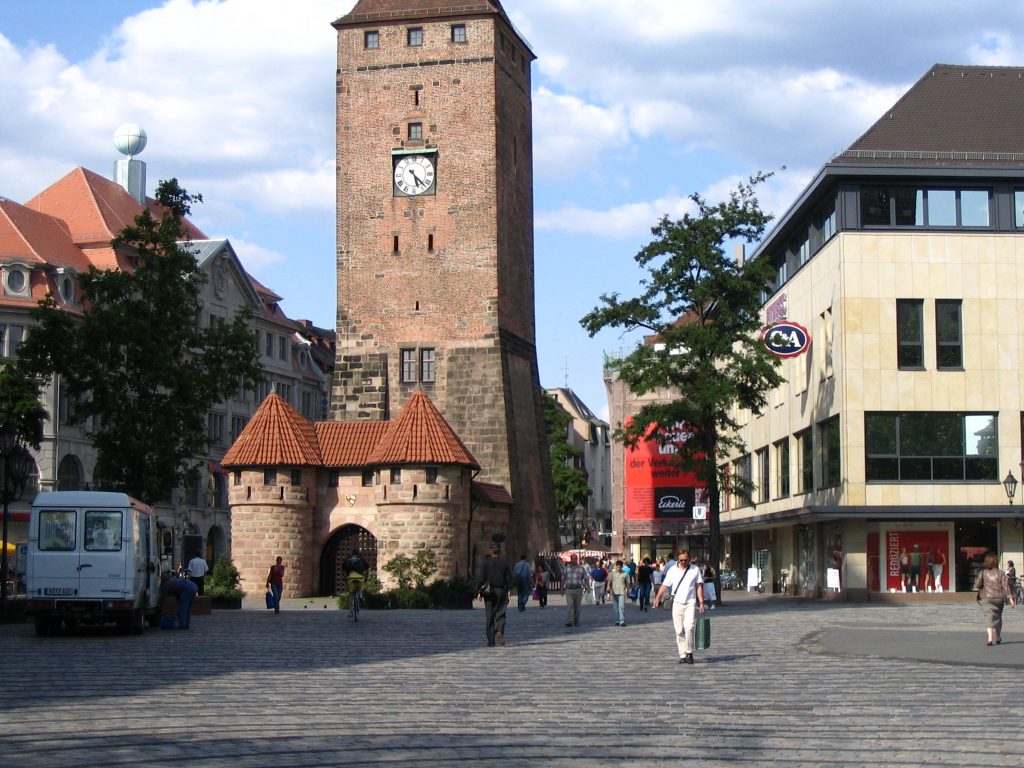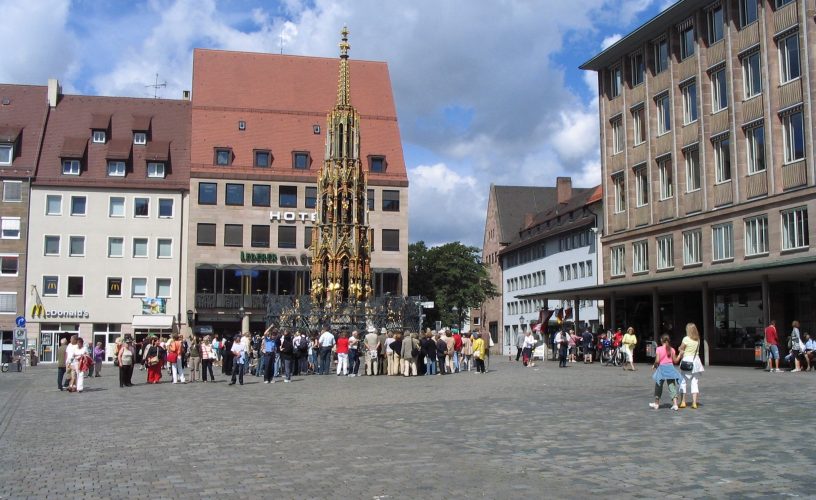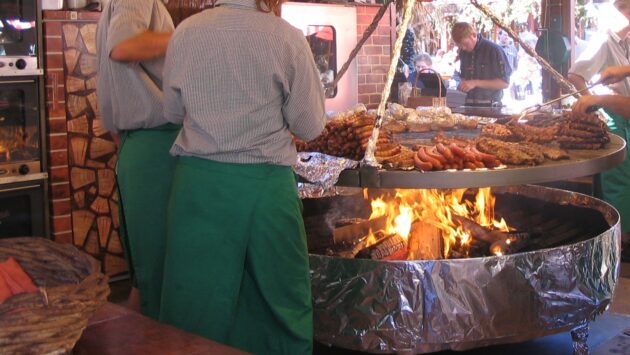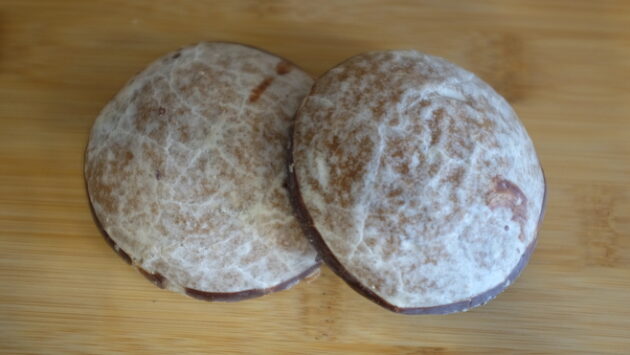Street Places
Nuremberg Street Places
Hauptmarkt
The Hauptmarkt (main market) Square is the setting for the traditional, world-famous Christkindlesmarkt (Christmas Market) that takes place every year from the Friday before the first Sunday of Advent.
Up until 1349. this was the site of the first, Jewish ghetto in Nuremberg, which was torn down during a pogrom.
This is the largest area which resembles a big trapeze sized 75 meters on the east line, 65 meters north and whole 85 meters towards the west side. Except being the largest place where people gather during the year as a Market Place when Christmas comes, this smaller marketplace becomes a great city square where you can enjoy yourself in all kind of activities. Being the regular marketplace during the year, you can find almost everything here, but almost all that you can by here, you can’t find in other places, because it’s all homemade.
So, from the flowers, fruit, vegetable, there are many stands where you can find homemade cookies, gifts, from small to the big ones, like mugs and fridge magnets, to remind you that this place is really something special.
This is a place of gathering for one other reason, and that is ‘The Beautiful Fountain’ or as they call it – Männleinlaufen (Little Men Dancing). This is something you mustn’t circumvent.
For this place, you can’t miss a time of year, or get here at the wrong time, because this is a place that offers every time, always different, and new. Every tourist who was here even once will tell you a different story, so make your own storey, because it will be unique.
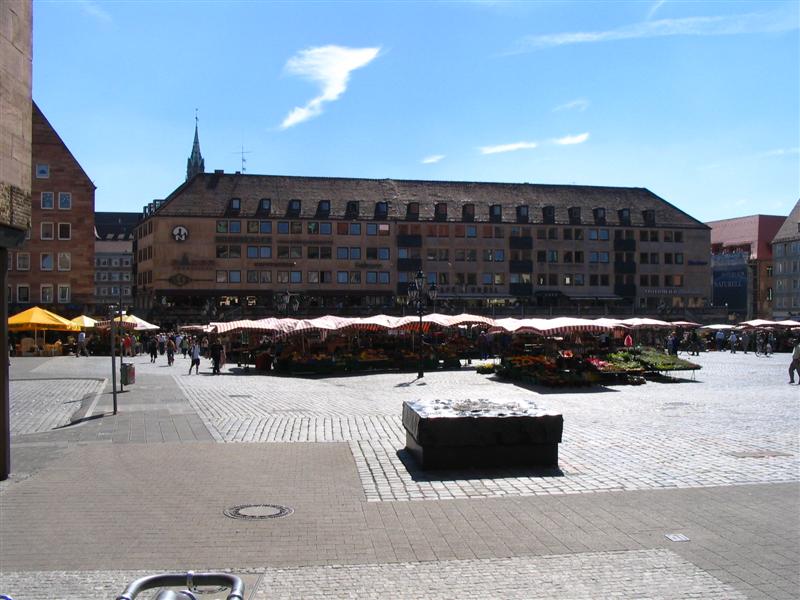
Handwerkerhof
Next to the Frauentor
The former weapons yard of the City of Nuremberg is famous today as a craftsmen’s yard. It was constructed as part of the Dürer Year in 1971 (to commemorate Dürer’s 500th birthday) in medieval style.
It documents the life and work of medieval craftsmen for visitors to the city.
In all the rush you are trying to see everything possible, here is the street, which is surrounded by the Nuremberg inner city wall, and the tower that once guarded the wall and the citizens of Nuremberg.
This is a place for peace and quiet, where you can walk slowly, and enjoy watching everything being made in front of your eyes. So, don’t be in a hurry all the time, this street has a lot to offer. Here you will see all kind of workshop, and antique craftsmen, where you can literally see how a hand full with clay becomes a teacup, or a bowl for eating, or something unique, that you can carry with you to remind you of these moments you can cherish forever. In this street, you’ll also buy a handbag, or maybe order one for yourself, but the leather workshop is there, and everything here is done by the hand. There is also a glass shop filled with light where the colours shine brightly, and polishing the vase has a different meaning. There’s also a metal workshop for all the metals, from bronze to the gold, where you can buy a souvenir or a wedding ring.
This ‘little village’ is a place for itself, and amazingly you don’t need to pay to get inside. The gate for exit is also an entrance for a train station.
When walking by the bakery, you will see how gingerbread cookies are made, and when you sense the smell, you won’t be able to move on without trying just one!
During the winter days, the picture here is much brighter, but still is the place where you can rest, try German sausages, and domestic beer of your choice.
There is also a window painting shop and the one where pralines are made by hand and carefully picked just for you. If you need a slower pace, and a place where no one can get lost, this is the right street for you. Here you will learn how the thing is being done, some of them even centuries back.
Street of human rights
Kartäusergasse
The “Street of Human Rights” is the most important public work of art in Nuremberg.
The articles of the Declaration of Human Rights are chiselled into a line of 29 columns and an oak tree, both in German and in a different foreign language for each article. The work was created by Dani Karavan and is situated right in front of the entrance to the Germanic National Museum.
Bask in 1988. twelve judges decided to extend the National Museum and the one that caught the judges eyes was the idea for the designing the extension project called “Way of Human Rights” by Dani Karavan.
It’s made out of stone and it has 27 pillars that are 8 meters in height, 80 centimetres in diameter, two pillars that are buried in the ground, and only round plates are visible on the ground, the gate and the oak tree in the row. In total there are 30 pillars. On every each of them there is a note from the Universal law for human rights, and, besides German, all 30 pillars have different language inscription on it, starting with Jidish, trough Netherland, Greece, China, Roman, Turkish, to Zulu and other rare languages. That was the window into new Nuremberg, and it’s new history, for old never to be forgotten, and for the future, to never repeat what was done in Germany during the last century. It’s more than 25 years since this row was done, and the Israeli artist who did the project wanted to always keep in mind what human rights are, and why it’s important for us never to repeat history on the global scale.
To mention that on all of the thirty columns and the gate are filled with 30 crucial laws ( better say rights ) in the United Nations Human Rights Council, founded in Schweiz in 2006. and since has been working on trying to offer every human being his or her basic rights as a human. Some of them are: We are all born free and equal, do not discriminate, the right to live, the right to have a family, the right not to be tortured, the right not to be enslaved, that we are all equal under the letter of law, right to have those rights wherever you go, right to privacy, freedom to move, freedom of thought and speech, and the last, but maybe the most important of them is that ‘No One Can Take Away Your Human Rights’
Füll
The unusual name for this street of houses can be traced back to a filled-in ditch on this site. It is the best-preserved historical street of houses in Nuremberg, with a row of noble townhouses and merchant houses. The most attractive of these are numbers 6, 8 and 12.
When you get to this street, you’ll find still standing a few houses that didn’t endure the sad history of the war that devastated the whole city.
Here you’ll see the old half-wooden houses that still stand there against the time. These colourful houses are mostly painted in white, with wooden parts painted in different colours, but it’s mostly bright red, some are orange, and on some of them you will see green or blue painted windows. Every one of those houses still has beautiful flowers, hanging down the windows, making this street even more beautiful.
Dating back to 12 and 13th century, original houses like this are made out of wood in structure, while the newer ones that have wood built in them are houses that have wood only as a decoration or to support structure that has already being made. So, houses like this you can only find in this street because they are untouched and has old oak wood built in them.
Some of them have bay windows, so nicely done, that every one of them will take your breath away.
When the night comes, you’ll clearly see old letters on wooden boards, remembering us of the time that passed by, but the beauty here rarely fades, because all of the houses are regularly repainted, every time it’s needed. In the evening, you’ll find a place to have a decent meal or just a drink. In any case, look at the design of them, that is something you’ll remember forever.
This street is so full of colours, that you will enjoy every step in it, and if you are artistic soul, wait for the sunny day, where everything will look much brighter.
Breite Gasse
The Breite Gasse was the starting point of the pedestrian zone in Nuremberg. In 1966 this street and the Pfannenschmiedgasse were developed into the first traffic-free zone in Nuremberg. Unfortunately, due to extremely high rents and the coming of large department stores, the pedestrian zone has lost a lot of its original character in the course of the years. Now it’s known by its other name or ‘The Mile Walk’ where you’ll find this building, which is not only the beginning of the same mile but a large shopping mall where you can spend the whole day inside.
If you try to get trough Nuremberg on foot, this is a great point to start off, but if you are not one of those willing to spend the whole day on your legs, this place, like other shopping malls, have to offer everything, from dusk till dawn. Inside, you will find everything you can possibly need, and we are talking about major European leading brands of everything.
In this piece of paradise for shoppers for brands, there are over 60 stores that sell the newest of the most famous brands in Europe. For the Breite Gasse, there is reserved 200parking spaces, because, whoever comes here, he or she knows why is there, and that the shopping below this roof will take a lot of your time.
So, if you are a trendsetter, or just want to have something of high quality ( where the prices follow the brand ) here you can find large Lego store, or how about St.Oliver’s, Zero, Benetton, Tom Tailor, and Esprit, which have a megastore under this roof.
There are many more stores, and of course, sort of a food court’s to relax, and back to your favourite brands of perfumes, clothes, watches and many, many more.
If you don’t like to walk that much, and you are here just for shopping, this is a perfect place for you.
